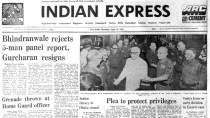- India
- International
Mani Shankar Aiyar writes: Queen Elizabeth, the empress without an empire
Mani Shankar Aiyar writes: By remaining a symbol of stability in a churning ocean of change, Queen Elizabeth upheld the torch of the monarchy by keeping her counsel to herself and reigning as a non-controversial monarch
 Mani Shankar Aiyar writes: Indeed, the jewel in the crown had been forced out a few weeks before she was married in November 1947. She was never, therefore, Empress of India.
Mani Shankar Aiyar writes: Indeed, the jewel in the crown had been forced out a few weeks before she was married in November 1947. She was never, therefore, Empress of India.If the British monarchy has survived into the 21st century, that has a lot to do with the manner in which Queen Elizabeth II carried the crown. It was a manner singularly free of the turbulence that surrounded the late Queen’s seven decades on the throne. The basic reason is that from her tutor at Eton who groomed her to become the symbol of her nation, she learned well the distinction that the 19th century British political scientist, Walter Bagehot, had drawn between a British monarch’s “dignified” and “efficient” duties. Had she deviated from that distinction and allowed the crown to get caught in a swirl of controversy, it is doubtful that King Charles III would so smoothly be stepping into the succession.
Queen Elizabeth was not destined to be Queen or Empress. If her uncle, Edward VIII, had not so detested the duties of being King (while revelling in the great comforts of the flesh which the throne conferred) he might have hesitated before marrying an American divorcee, thus bringing on his abdication. It was only this that brought his brother, Albert, to the throne as George VI, a role he played with grim determination despite the handicap of never having been prepared for it, not wanting it, and suffering from a speech defect that rendered every public statement an agony for his tormented soul. Also, her parents had failed to give the family a son, and thus, at 25, Elizabeth, his eldest daughter, had to fill in when George VI died in 1952. It was symbolic of the times that she was on holiday in Kenya, a distant corner of the Empire with her husband Philip, Duke of Edinburgh, when she learned that her father had passed away and she was required to succeed him. It was an Empire that was marked by history to fade away before she had quite completed a decade on the throne.
Indeed, the jewel in the crown had been forced out a few weeks before she was married in November 1947. She was never, therefore, Empress of India. Notwithstanding that, her reign extended at the start over a vast swathe of the world, encircling the globe from the West Indies on the far side of the Atlantic Ocean to numerous colonies in west, east and southern Africa to a host of islands in the Pacific, besides the White Commonwealth where the inhabitants fought against the 20th century by remaining monarchies even after attaining full Dominion status. Her most doleful duty was to preside over the independence ceremonies of virtually every one of these distant outposts of the Empire. She did so with dignity, never letting nostalgia for the past lend a touch of gloom to the change of guard. In this, she was greatly assisted by the pageantry with which her husband, Philip, and her uncle, Prince Louis Mountbatten, were obsessed: Medals, uniforms, brass bands, orders of precedence and other baubles. The Empire, therefore, slid with dignity from her young shoulders while, thanks in large measure to Jawaharlal Nehru, she remained the Head of the Commonwealth. In that capacity, she brought continuity to historical change and greatly helped the transition from a colonial relationship fraught with bitter memories to a new, modern relationship between friendly sovereign countries.
In all this, she was greatly assisted by her strict training to not say anything controversial, remain politically neutral and to be guided by the elected government of the day in her home country. She stuck to the dull but dignified line they put out. She was also thus able to survive the many gaffes that her irrepressible husband tended to make on many of these solemn occasions — as, for instance, remarking in the hearing of the press that the son of General Dyer, the Butcher of Jallianwallah Bagh, had told him that the number of deaths in 1919 had been hugely exaggerated. It wrecked the goodwill that the Queen and her government were hoping to rake in from ceremonially touring India on the 50th anniversary of Independence.
By then, the Crown had suffered far greater embarrassment back in the UK. It began with the rumpus over her sister, Princess Margaret, wanting to marry a divorced commoner, but gathered steam in the social (and sexual) revolution associated with the rise of the Beatles generation, which, along with contraceptives for women, ushered strait-laced Britain into the Swinging Sixties. That promoted so much irreverence that it could not but touch Buckingham Palace. So, when Diana, the People’s Princess, married and then divorced the heir to the throne, there was a huge wave of public sympathy for her, accompanied by an equal measure of distaste for her married alternative. When Diana died in a car crash in Paris in 1997, it seemed the throne might be shaken. There has since been no lack of scandal swirling around Elizabeth II’s other children and grandchildren.

If Elizabeth II survived this social tumult, it was because British democracy and the monarchy knew how to change with the times. By remaining a steady symbol of stability in a churning ocean of change, the Queen upheld the torch of monarchy by keeping her counsel to herself and continuing to reign as a non-political and non-controversial Queen. This required the greatest restraint and adherence to what she had been taught as a young woman about the role and duties of the British sovereign. While her own family were plagued with personal issues and her country underwent the most profound changes in its adjustment to the new world order, including pleading its way into Europe and then petulantly walking out, the Palace was never part of any argument and steadily maintained the course of continuity.
When she first became Elizabeth II, with Edmund Hillary and Tenzing Norgay conquering Everest on the eve of her coronation, it was fondly believed by most of her subjects that even as Britain under Elizabeth I had started her quest for greatness, so under Elizabeth II, would Britain be restored to world dominance. Instead, the Empire of her predecessors was dismantled brick by brick and, as Dean Acheson, the US Secretary of State remarked cruelly but truly in 1962, Britain had “lost her Empire and failed to find a role”. It is to the credit of Elizabeth II that even while retracting from the world dominance that Elizabeth I had initiated in the 16th century, half a millennium later, she held her own in a period of national retreat. That surely will remain the lasting monument to her reign. Britain remains — for now at least — a monarchy, while kings and queens around the world lose their crowns and oftentimes their heads too.
The writer is a former Union minister
EXPRESS OPINION
More Explained
Apr 26: Latest News
- 01
- 02
- 03
- 04
- 05










































